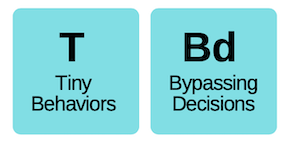3 Easy Techniques to Quickly Add Habits
Snapping on habits to established routines doesn’t have to be complicated.
Basic habits as I’ve been discussing them are trigger-responses that gradually become automatic. There’s a progression to them - across time they begin to effect identity, taking less executive functioning and willpower to last long-term.
I usually formalize them with an implementation intention (an if-then statement), a mental contrasting exercise (brainstorm your “why” in addition to stumbling blocks and their workarounds), and record them using the SRHI (Self-Report Habit Index). They have a pattern, following a natural log function, and take weeks, sometimes months, to fully form.
But over the last few years I’ve noticed I can also add behaviors that seemingly just snap on. They involve slightly different mechanisms that may appear obvious, but also have long lasting effects for less hassle:
1. SET IT AND FORGET IT
When I changed my sleep hygiene to avoid blue light at night, I didn’t formalize a habit like I normally do. I just used an app.
The one I use, f.lux, is really simple - you install it and it’ll naturally filter blue light depending on the time. Setting the thermostat to automatically get cooler at night is another example of this, and is also great for sleep hygiene. I’ve just discovered Bixby Routines on Samsung, where I can program all sorts of functions to occur automatically on my phone depending on the time of day, location, and even what WiFi signal my phone logs on to.
Analyzed in terms of behavior, these usually involve extremely small changes and are technology driven, bypassing decision making entirely.
Sometimes the positive loop can feed on itself. I’m less inclined to look at filterless screens at night, and more likely to dim lights even when I don’t have my app on hand.
The obvious downside is that if you don't have access to your technology (or charged) things can fall by the wayside.
2. COMPRESSION
Do something small that fits between two larger behaviors, and it’s more likely to last. For example, I love Mark Sisson’s idea of micro workouts done as breaks between Pomodoro work sessions throughout the day.
In many ways it’s similar to using the replacement strategy to change a habit. You trade out the response while keeping the already established cue and reward.
But here, there’s a synergy that can develop - what I’ve described in the past as habit harmonics, when two habits become better and more sustainable than one. Small workouts keep you energetic for work focus without tiring you out. At the same time, they make working out far more palatable and Tiny. It just becomes buried within your day.
*I’m using the gray diamond to indicate a possible new behavioral Element
There’s also a subtle push for productivity just because you’re abutting against another habit, and that synergy acts as a reward for both behaviors.
The downside is you often have to have your actions carefully preplanned. There’s just no time to fumble around looking for what you have to do.
3. FIAT
Another method that works is simply formally declaring a small change. One example of this is what I’m calling an “implemented ritual” - a simple statement of intent with something that’s really small and involves some item or gadget.
For example, I have a sitting desk, also courtesy of Mark Sisson. I decided that I’m just going to sit there rather than at a regular table. Similarly I’ve started drinking water out of a specific cup as soon as I get out of bed instead of coffee.
In both cases they became automatic quickly.
Its tiny-ness is part of the reason of why it works so well. But it’s also oddly ritualistic because they both involved gear, tying associations to an object. It’s like a habit, but it’s not a grind. With some of these types of behaviors I feel pulled into doing them because of the new contraption I have, like a reward. You get to do something with a novel object. I think this works by offsetting motivation with Tinyness, Novelty, Rewards, and Ritual until it becomes automatic
OTHER SNAPON BEHAVIORS
There are other methods, but they are not both quick AND easy.
I did not include Rituals or falling in love with an action. Both involve mindfulness, both often involve some sort’ve implements or gear, and both act as a reward, unlocking immense amounts of focus instead of draining them. I think these might be significantly easier than normal habits, but might be more involved in their setup. I’m also not fully certain how these work yet.
I also did not include my attempts to form a habit in a day. In my experiments with this I’ve created habits in far less time than the standard 66 days, but they involve quite a lot of up front effort.
REPURCUSSIONS
All of these behaviors are small, but that does not in any way imply that they are less important.
For health, this could be ground breaking. It’s already changed my sleep hygiene, and I’m now implementing micro workouts and screen breaks for eye health throughout the day.
But beyond this, it means that habits don’t have to just come from one configuration of the Elements of Change. The more change is offloaded off one method, the less it’s relying on that limited resource.
Theoretically, it could mean easily changing a whole host of behaviors across a wide spectrum really fast.



